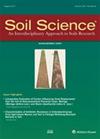Masked diversity and contrasting soil processes in tropical seagrass meadows: the control of environmental settings
4区 农林科学
Q2 Agricultural and Biological Sciences
引用次数: 1
Abstract
Abstract. Seagrass meadows are among the most valuable ecosystems on Earth. However, in tropical countries, there is a substantial knowledge gap in “seagrass science”. To address this gap, seagrass soils from three Brazilian coastal regions were investigated (the northeastern, southeastern, and southern coasts). Soil profiles from different geological and bioclimatic settings were sampled, described, and analyzed. Thus, detailed macromorphological descriptions, soil classification, physicochemical analysis (soil particle size, soil pH, pHoxidation, Eh, total organic carbon: TOC), Fe partitioning, and X-ray diffractometry were performed. Additionally, water samples were analyzed for pH, salinity, and ion concentrations. Different environmental settings in the coastal compartments produced contrasting geochemical conditions, which caused different intensities of pedogenetic processes. On the northeastern coast, the denser plant coverage favored higher TOC contents (2.5 ± 0.1 %) and an anaerobic environment (Eh = +134 ± 142 mV) prone to an intense sulfidization (i.e., pyrite formation: Py-Fe). Py-Fe contents in northeastern soils were 6- and 2-fold higher than in southeastern and southern coastal soils, respectively. Conversely, lower TOC contents (0.35 ± 0.15 %) and a suboxic environment (Eh + 203 ± 55 mV) in the southeastern soils, along with the Fe-rich geological surroundings, decreased the intensity of gleization. The contrasting intensities in the soil processes, related to the (seemingly subtle) differences in the geochemistry of each environment, ultimately caused relevant pedodiversity among the studied sites. Our findings contribute to a better understanding of the general functioning of tropical seagrass meadows but also have significant environmental implications for studies focused on carbon sequestration in these ecosystems.热带海草草甸的隐蔽多样性和对比土壤过程:环境设置的控制
摘要海草草甸是地球上最有价值的生态系统之一。然而,在热带国家,在“海草科学”方面存在很大的知识差距。为了解决这一差距,研究人员调查了巴西三个沿海地区(东北部、东南部和南部海岸)的海草土壤。对不同地质和生物气候背景下的土壤剖面进行了采样、描述和分析。因此,进行了详细的宏观形态描述、土壤分类、理化分析(土壤粒度、土壤pH、氧化、Eh、总有机碳:TOC)、铁分配和x射线衍射。此外,还分析了水样的ph值、盐度和离子浓度。不同的海岸隔室环境条件产生了不同的地球化学条件,导致了不同程度的成土作用。在东北海岸,较密集的植被覆盖有利于较高的TOC含量(2.5±0.1%)和厌氧环境(Eh = +134±142 mV),容易发生强烈的硫化(即黄铁矿形成:pyfe)。东北土壤中磷铁含量分别是东南沿海和南部沿海土壤的6倍和2倍。相反,东南土壤TOC含量较低(0.35±0.15%)和亚氧环境(Eh + 203±55 mV)以及富铁地质环境降低了闪化强度。土壤过程的对比强度,与每个环境的地球化学差异(看似微妙)有关,最终导致了研究地点之间相关的土壤多样性。我们的发现有助于更好地理解热带海草草甸的一般功能,但也对这些生态系统中碳封存的研究具有重要的环境意义。
本文章由计算机程序翻译,如有差异,请以英文原文为准。
求助全文
约1分钟内获得全文
求助全文
来源期刊

Soil Science
农林科学-土壤科学
CiteScore
2.70
自引率
0.00%
发文量
0
审稿时长
4.4 months
期刊介绍:
Cessation.Soil Science satisfies the professional needs of all scientists and laboratory personnel involved in soil and plant research by publishing primary research reports and critical reviews of basic and applied soil science, especially as it relates to soil and plant studies and general environmental soil science.
Each month, Soil Science presents authoritative research articles from an impressive array of discipline: soil chemistry and biochemistry, physics, fertility and nutrition, soil genesis and morphology, soil microbiology and mineralogy. Of immediate relevance to soil scientists-both industrial and academic-this unique publication also has long-range value for agronomists and environmental scientists.
 求助内容:
求助内容: 应助结果提醒方式:
应助结果提醒方式:


